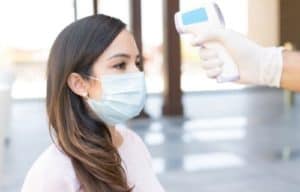
QUESTION: We are very confused about which COVID-19 PPE requirements our practice should follow. We are an ophthalmology practice, and we don’t allow symptomatic patients to come in. Should we still mandate that some or all of our staff wear masks? How about our front desk staff that just check patients in and out?
Question from Jacksonville, FL subscriber
ANSWER: Even if you don’t allow symptomatic patients in your practice, you must consider that a patient can test positive without exhibiting symptoms. When someone with the coronavirus coughs or sneezes, it creates a turbulent cloud of virus-containing droplets in the air that are continuously falling. If you’re standing closer than six feet apart the droplets are in prime location to enter your respiratory system through your eyes, mouth, and nose.
It’s for this very reason that you should have a coronavirus protection plan in place for your practice outlining the personal protective equipment (PPE) that each staff is required to wear, and when.
Step 1: Look to OSHA, CDC for Guidance on COVID-19 PPE Requirements
There are a lot of recommendations for wearing PPE. OSHA and the CDC offer their guidance based on what they know about the transmission of the virus.
- The Occupational Safety and Health Administration (OSHA) provides regulations and guidance for workplace health and safety. OSHA’s recommendations will help you remain in compliance with their standards for respiratory protection and other PPE, which you are required to supply for employees to protect them from any potential infectious disease exposure.
- The Centers for Disease Control and Prevention (CDC) offers guidance for what PPE should be used—and under what circumstances—to prevent exposure to infectious diseases.
Step 2: Identify Staff Exposure Risk Level
There’s no one-size-fits-all approach to PPE requirements for practice employees. Instead, you must look at each individual employee’s duties and assess their risk level based on that. OSHA recommends you evaluate employee exposure based on these risk levels:
- Low exposure risk: Your low-risk employees are the ones who perform administrative duties in non-public areas of your practice, away from other staff members. These include, for example, providers supplying telemedicine only services, back office billers who don’t interact with patients or much staff. Note: For activities in the lower (caution) risk category, see OSHA’s Interim Guidance for Workers and Employers of Workers at Lower Risk of Exposure.
- Medium exposure risk: Your medium-risk employees are the ones who are providing care to the general public who are not known or suspected COVID-19 patients. Specifically, this includes your front office receptionists. Their potential exposure risk comes from greeting and talking to patients.
- High exposure risk: Your high-risk employees are the ones who are entering a known or suspected COVID-19 patient’s room or providing care for a known or suspected COVID-19 patient. These employees are not involved in aerosol-generating procedures. High-risk employees include your clinic manager, clinic owner, nursing staff, MA clinical care, providers, or anyone directly interacting with patients who are known or suspected COVID-19.
- Very High exposure risk: Your very high-risk employees are the ones who are collecting or handling specimens from known or suspected COVID-19 patients. They are performing aerosol-generating procedures (e.g., intubation, cough induction procedures, bronchoscopies, some dental procedures and exams, or invasive specimen collection) on known or suspected COVID-19 patients.
Step 3: Provide PPE
After considering each employee’s job functions and assessing their risk level, you can then select from a number of personal protective equipment (PPE) that will keep your staff safe while they work, protect them from infection, and slow the spread. When choosing PPE for your practice staff, look at their anticipated exposure, the durability of the PPE, and the fit. It’s up to you to provide PPE in sizes that are suitable for all your employees.
The CDC offers guidance for selecting and using PPE in a healthcare setting, which takes into account these pieces of equipment:
- Gloves protect hands and most of the time employees will only require a single pair of nonsterile latex, nitrile, or vinyl gloves. The gloves should fit snug on the hand—not too loose or too tight—and around the wrist. Sterile surgical gloves are worn by surgeons and other healthcare personnel who perform invasive patient procedures. Two pairs of gloves can be worn when performing surgical procedures, and heavy duty gloves are helpful when working with caustic disinfectants when cleaning.
- Gowns or aprons protect skin and/or clothing. If you suspect limited contamination, an apron will suffice. If you suspect contamination of the arms, wear an isolation gown. Make sure gowns fit properly; they should cover the torso, fit comfortable on the body, and have long sleeves with snug wrists. Wear a fluid resistant gown if fluid penetration is likely, and always wear a sterile gown when performing an invasive procedure.
- Masks protect the nose and mouth and should fit snugly for best results.
- Goggles should fit snuggly over and around eyes or prescription glasses for protection. An antifog feature will improves clarity. The CDC recommends eye protection when in areas with moderate to substantial community transmission. In instances with no community transmission, consider eye protection optional.
- Face shields protect the entire face and should cover the forehead, extend below the chin and wrap around the side of the face. It should fully cover the nose and mouth to prevent fluid penetration.
- Respirators protect the respiratory tract from inhalation of infectious aerosols. When selecting a type, consider the type of exposure. The N95 particulate respirator might be a good option for staff interacting with a COVID-19 patient, but a a powered air-purifying respirator or PAPR might be needed if the patient needs a bronchoscopy.
For more proven disinfection methods, along with step-by-step guidance on how to successfully protect your office from spreading COVID-19, infectious disease practitioner, Javeed Siddiqui, MD, MPH, can help. During his complimentary online training “Protect Your Practice with Proven COVID-19 Disinfection Protocols,” you’ll get answers to frequently asked COVID-19 practice disinfection protocol questions.



